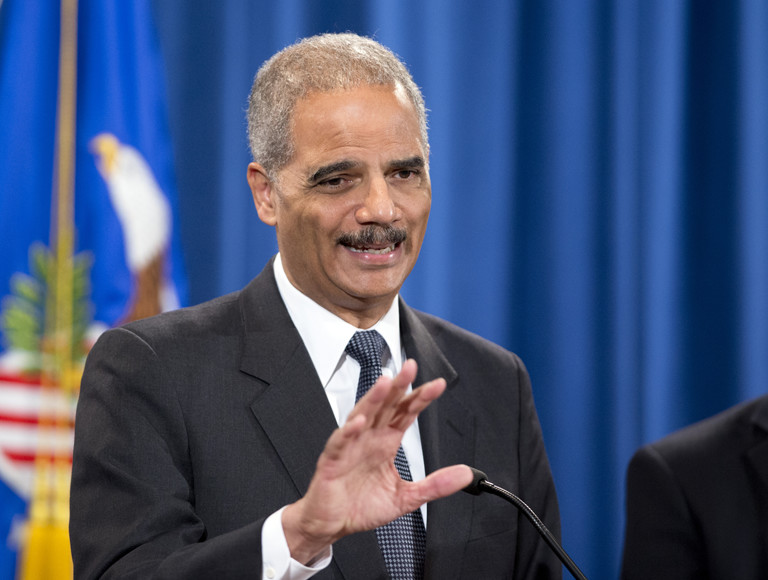
Fighting Over The Fine Print,
Shielding The Boss,
Pleasing
Wall Street
Only for the Elderly, Only for a Short Period
By fall 2013, the government and Johnson & Johnson had settled on a new number: $2.2 billion—$500 million in criminal fines and forfeitures and $1.7 billion for civil damages. Of the total, $335 million was to settle the Omnicare Boston suit and the San Francisco suit related to the heart drug Natrecor. This made the Risperdal portion the largest settlement ever for the illegal marketing of one drug.
What a Good Lawyer Can Save You
(Or Why J&J Wanted To Pay More in Civil Damages)
Total proposed fine
(Tax Deductible)
(Non-Tax Deductible)
$30 Million
( versus a 100% criminal fine )
As planned, Johnson & Johnson—actually the Janssen unit, a distinction that the J&J lawyers fought for—would plead guilty to one misdemeanor related to marketing to the elderly.
That infuriated Sheller and other plaintiffs lawyers for a simple if non-obvious reason: Getting J&J to admit to selling off-label to the elderly didn’t help them nearly as much as getting them to admit to all of the alleged off-label activities related to children—from the Biederman effort, to the Lego toys, to the “re-analyzing” of the prolactin/gynecomastia data.
Why? Because the children offered far more winnable plaintiffs’ damage cases.
Why? Because while it might be true that thousands, maybe tens of thousands, of elderly patients who took Risperdal had died of strokes or complications from related cardiovascular diseases or diabetes, how was a lawyer supposed to prove that an 80-year-old’s stroke was the result of Risperdal or anything else? A boy with 46DD breasts was a different story.
But the government lawyers didn’t care about the trial lawyers’ problems. They wanted to complete the deal. And if the Johnson & Johnson lawyers wanted it to be about the elderly, that was fine with the government. The standard was one corporate misdemeanor plea. The specifics didn’t much matter.
Besides, there seemed to be a certain symmetry in making the plea relate to the elderly, because the other big case being settled, Omnicare, was all about the elderly. And the FDA data about the drug causing strokes and J&J’s refusal to pay attention to it was damning enough. Grandfathers and grandmothers in nursing homes suffering from Alzheimer’s being given a drug approved only for schizophrenics would be a compelling story for the attorney general to tell when it came time to announce the deal at a press conference.
Still, Sheller thought Johnson & Johnson’s distortion of the prolactin/gynecomastia data related to children was its most unforgiveable offense, and was what the company should have been forced to admit to. He threatened, he says, to withhold his approval. However, he knew in the end that he couldn’t. How could he ethically serve his client in this case, Vicki Starr, if he tried to derail the deal just to help the cases he was gathering representing all of those young boys?
But there were other elements of the deal that the two sides still had to negotiate.
In a series of bargaining sessions that ate up months of meetings that were often weeks apart, the two sides fought over how long a period J&J would admit to pushing the drug off-label to geriatrics.
The government wanted the company to admit to off-label selling over the 12-year period that the evidence indicated: from the drug’s introduction in 1994 to 2006, by which time the company had stood down and disbanded the ElderCare unit because it knew about all of the investigations. J&J wanted the shortest period possible, and argued that it should range only from March 2002, when the label had been narrowed from “psychotic disorders” to only schizophrenia, to December 2003, when the label had been expanded slightly to include short-term treatment for bipolar disorders.
In a way, this narrow window made sense. The data showed that 90 percent of prescriptions to the elderly were off-label during that abbreviated period, and 80 to 85 percent were during the time after December 2003. But an 80 to 85 percent rate of off-label sales was still glaring evidence of illegal promotion. In other words, the Johnson & Johnson lawyers were saying that their client was only willing to admit to the absolute worst of its conduct. That would allow the company to tell the press and Wall Street that the company had admitted to misbehaving for a period of months (21) rather than a period of years—a short blip in the Credo company’s long history.
The company dug in, according to lawyers on both sides.
“It makes no difference to you—you get your plea and your money, but we need this,” is how one lawyer said J&J’s argument was expressed. “Otherwise, the company wants to fight it. These are proud people. Give us something to deliver to them.”
Another argument they used was the corporate First Amendment claim.
That theory had been picking up steam in unrelated court decisions around the country—including some from the Supreme Court—since it had been tried against the FDA in 1997. That was the case that had resulted in a standoff after the FDA said that its guidelines related to off-label promotion did not make speech itself illegal. Then in December 2012, the Second Circuit Court of Appeals—the New York-based court that is just a rung below the Supreme Court—had thrown out the conviction of a drug company’s salesman for selling drugs off label, ruling that his pitches were protected by the First Amendment.[1]
There were differences between that case and the issues in the Risperdal investigation. The appellate judges had ruled, consistent with the FDA’s clarification of its guidelines, that the salesman’s speech alone could not be grounds for a conviction. The reason they had overturned the conviction, the judges wrote, was that the prosecutors and the judge had told the jury at the close of the trial that his speech alone, in fact, could convict him. His speech could only be used as evidence, the judges ruled, that he or his company committed the act of putting the drug into interstate commerce for a purpose not approved by the FDA.
There was lots of that evidence in the Risperdal case—the explicit business plans, for example. And the Second Circuit had also confirmed that misleading or inaccurate speech was not protected. The Risperdal prosecutors had evidence of that, too.
Still, the First Amendment defense was not something the Justice Department lawyers in Washington were eager to test over something as incidental as the time period Johnson & Johnson was willing to agree to.
Months of intermittent meetings followed through the summer of 2012 and into the fall and then winter. Sometimes they were weeks apart. Johnson & Johnson was in no hurry to part with its money and admit a crime, and the Justice Department lawyers, especially those at Main Justice in Washington, always seemed to have other cases to deal with.
Finally, sometime in the winter of 2013, the government agreed to let J&J plead guilty to off-label promotion only to the elderly and only during that abbreviated time period.
But it still wasn’t over.
Worried About the CIA
All of these plea deals also require the offending company to negotiate something called a Corporate Integrity Agreement, which allows the government to play hall monitor inside the company. These agreements, negotiated and enforced by the staff of the Department of Health and Human Services’ inspector general, had become so common that in healthcare industry circles the acronym CIA had nothing to do with spies.
The government was going to try its hand at enforcing the Credo.
A CIA forces a company to submit itself, usually for five years, to steps designed to reform its conduct. For example, the inspector general’s lawyers demanded that Johnson & Johnson change the way it paid bonuses to salespeople so that they were no longer compensated for off-label sales. In short, the government was going to try its hand at enforcing the Credo.
Compliance with these and other changes was to be reviewed regularly by a new committee of the J&J board, whose members had to sign a report to the inspector general each year attesting that everything was in order.
All of this was negotiated in fine detail. How many reports a year, covering what subjects, and in what form? How many members of the new committee of the board set up to supervise compliance did there have to be?
It’s a complicated process; the final document in this case was 66 single-spaced pages. However, it usually gets done without the kind of brinksmanship that accompanies the larger issues. This time, the negotiations dragged on because Johnson & Johnson—making the argument that it is an unusually decentralized company in which the parent gives its subsidiaries broad management responsibility—wanted everything to apply only to its Janssen unit, not to the iconic parent.
There was also an issue related to how the CIA might affect Gorsky. A controversy had erupted in the drug industry in 2011 when the inspector general tried to use certain clauses in the CIA it negotiated with Forest Laboratories to force the removal of the longtime CEO as a condition of the company not being barred from selling to Medicare or other federal agencies. Because the CEO had presided over the wrongdoing that had been uncovered, the inspector general argued, nothing in the Corporate Integrity Agreement could be relied on if he remained in charge.
In the end, the inspector general relented, but since then, defense lawyers had eyed the CIA and the inspector general with special care.
For that reason, Johnson & Johnson lawyers, according to one of them, thought they should get some kind of promise from the inspector general that they would not use Gorsky’s involvement in the Risperdal sales campaigns to try to bar him from running J&J. However, getting such assurances in writing was a non-starter, because they would be publicly disclosed, causing further embarrassment to the boss.
The best they could do was get verbal assurances—“a series of meetings with lots of winks and nods,” is how one lawyer described the process—from the inspector general that he had no intention of trying to force Gorsky’s departure.
Finally, the deal was done.

A $2.2 Billion Payout, and a Bump in the Stock
On November 4, 2013, Attorney General Eric Holder announced the Justice Department’s $2.2 billion settlement with Johnson & Johnson. The company had “recklessly put at risk the health of some of the most vulnerable members of our society—including young children, the elderly and the disabled, ” Holder charged.
The text of the civil complaint spelled out all of the allegations about off-label selling to children, including Sheller’s discoveries about prolactin, but focused more on illegal promotion to the elderly, which was the sole subject of the criminal charge and misdemeanor plea agreement.
The New York Times’ Katie Thomas wrote that, “Much of the conduct highlighted in the case, which for Risperdal extends from 1999 through 2005, occurred while Alex Gorsky was vice president for sales and marketing and later president of the company’s pharmaceutical unit, Janssen. Mr. Gorsky became chief executive of Johnson & Johnson last year.”
She then quoted a J&J spokesman, who “noted that the misdemeanor charge was being entered on behalf of the company and no individuals were charged with wrongdoing. ‘Mr. Gorsky has been an outstanding Johnson & Johnson leader for more than 20 years,’ he said.”
In a separate statement, Johnson & Johnson declared that it “expressly denies” the allegations in the civil complaint—which the company had just settled, and which, unlike the criminal complaint, had detailed the evidence of off-label sales to children.
The only slight hitch for Johnson & Johnson came three days later when the prosecutors and company lawyers presented their plea agreement to Philadelphia federal district judge Timothy Savage for his formal approval. Company lawyer Joseph Braunreuther was tasked with pleading guilty in open court to the misdemeanor on behalf of the company and then confirming his agreement with the prosecutors about the fines to be paid. He began instead by describing how his client was “responsible for the delivery of valuable therapy that changes people’s lives around the world…and remains committed to improving human life going forward.”
Savage interrupted. “Does it do that from an altruistic motive or a profit motive,” he asked. “It was the profit motive that drove this program, didn’t it?”
After Braunreuther conceded the point, the judge vented about how the company had marketed the drug “in a calculated manner” to “elderly patients with dementia and mentally disabled children, which were not approved uses.”
Asked whether he thought the outcome of the case was fair, Savage declined comment, except to remind me of the rule governing the type of plea J&J and the prosecutors had negotiated. It stipulates that a judge cannot toughen the penalty on his own, even if he wants to.

‘Our Moral Compass’
Less than two weeks after the settlement, Barron’s published an exclusive interview with Gorsky. In recounting the challenges he confronted as he took over the company—the Tylenol recalls, the suits about allegedly defective hip replacements and the vaginal mesh product and, now, the Risperdal settlement—reporter Leslie Norton wrote, “Many faced with this particular set of challenges might turn to prayer. Gorsky did the corporate equivalent: He dusted off the company’s 300-word credo, penned 70 years before by J&J’s General Robert Wood Johnson, scion of the company’s founders.”
“It is our moral compass, and should stay the same,” Gorsky told the reporter. As for the $2.2 billion settlement, “These settlements have allowed us to take appropriate accountability to move forward,” he said.
The article ended with the CEO recalling what he had learned at Army Ranger school: “No matter what obstacle you face, you are going to find a way to get over it, through it, around it, under it.”
On the trading day before the settlement was announced, Johnson & Johnson stock closed at $93.37. A week after the announcement, it closed at $94.29. A year later, as thousands of Risperdal personal injury suits were pending, it would close at $108.62.
Vicki Starr and Stephen Sheller refuse to discuss how much she, or he, earned from the government settlement. But it was more than what she expected back in 2012, when the lawyers on both sides thought they had agreed on a $1.3 billion deal, of which $900 million would be for the false claims in her qui tam suit. Now, the false claims related to her suit were about $1.2 billion, and the whistleblowers were entitled to 15 percent. Assuming that she and the four other whistle-blower “relators” who had come forward got equal shares (which they probably didn’t because she might have gotten more for being the first, while the last relator might have gotten more for having pivotal information derived from his status as a former Janssen manager), and assuming 33 percent off the top in attorneys fees, Starr ended up with about $24 million, before taxes.
Starr has since moved back to Portland, where she and her husband have just finished remodeling a house they bought in a gated community on the water. Their boat is docked just below the living room. (According to a real estate website, their home was last purchased for $716,000 in February 2014.)
Starr says she has become “an avid food blogger” and an active volunteer pharmacist for a local mental health patients group. Once a year, she has what she calls “a celebratory dinner” with Hector Lopez, the Eli Lilly whistleblower, who set her up with Sheller (and who got his own payout when Lilly settled with the government for similar, though lesser, charges.)
For Sheller, however, the hardest work was just beginning: fighting the hundreds of personal injury cases he had now filed for boys with breasts.
[1] On August 7 of this year, a federal district court judge in Manhattan, citing that appellate court decision, ruled that a drug company could provide truthful promotional materials about its cholesterol drug to doctors interested in using it for patients whose cholesterol levels were below the extremely high level for which the FDA had limited its approved use.